Vintage 4X spoking question
#1
Senior Member
Thread Starter
Join Date: Jan 2019
Location: Toledo Ohio
Posts: 1,497
Bikes: 1964 Huffy Sportsman, 1972 Fuji Newest, 1973 Schwinn Super Sport (3), 1982 Trek 412, 1983 Trek 700, 1989 Miyata 1000LT, 1991 Bianchi Boardwalk, plus others
Mentioned: 21 Post(s)
Tagged: 0 Thread(s)
Quoted: 583 Post(s)
Liked 700 Times
in
395 Posts
Vintage 4X spoking question
A couple years ago I got a vintage Campagnolo Record high flange wheelset laced to Super Champion 58 rims. I remember truing it at that time. I put a couple hundred miles on it with no problem. Since then I got a tension meter and have been going through wheels and changing out vintage nipples in poor shape etc on other bikes. This is 36 hole rear and 4X with vintage db spokes. I only observe this on the nds side rear, and not in the front wheel at all. I didnít build this wheel.
While messing with it, I noticed on the non drive side rear there is quite a discrepancy in how much thread shows entering the nipple from the hub. It is a regular pattern between the pulling and following spokes. Iím not sure which are which. The whole batch is either just right or 3-4mm shorter. I put my newly purchased spoke ruler up to the mounted wheel and indeed the distance from the hub spoke hole to the rim was consistently off in that regular pattern. So, did someone start at the wrong hub hole on that side, or finish at the wrong spot on the rim? Guesstimating from looking at it, it almost seems that moving each spoke on this side two spots over on the rim would perhaps correct things. My other guess was that all the spokes on this side would need to come out and start one hole over on the hub? It does seem when comparing to the front rim that the sides donít match clockwise vs counterclockwise of the other side if that makes sense. Thoughts?
While messing with it, I noticed on the non drive side rear there is quite a discrepancy in how much thread shows entering the nipple from the hub. It is a regular pattern between the pulling and following spokes. Iím not sure which are which. The whole batch is either just right or 3-4mm shorter. I put my newly purchased spoke ruler up to the mounted wheel and indeed the distance from the hub spoke hole to the rim was consistently off in that regular pattern. So, did someone start at the wrong hub hole on that side, or finish at the wrong spot on the rim? Guesstimating from looking at it, it almost seems that moving each spoke on this side two spots over on the rim would perhaps correct things. My other guess was that all the spokes on this side would need to come out and start one hole over on the hub? It does seem when comparing to the front rim that the sides donít match clockwise vs counterclockwise of the other side if that makes sense. Thoughts?
#2
Really Old Senior Member
Take off the rim tape and look at the end of the spoke vs the screw driver slot.
I can't speak for that specific hub, but typically, the NDS spoke needs to be 1-2mm longer than the DS spoke.
I can't speak for that specific hub, but typically, the NDS spoke needs to be 1-2mm longer than the DS spoke.
#3
Senior Member
Join Date: Apr 2016
Posts: 1,245
Mentioned: 3 Post(s)
Tagged: 0 Thread(s)
Quoted: 505 Post(s)
Liked 437 Times
in
336 Posts
While messing with it, I noticed on the non drive side rear there is quite a discrepancy in how much thread shows entering the nipple from the hub. It is a regular pattern between the pulling and following spokes. Iím not sure which are which. The whole batch is either just right or 3-4mm shorter. I put my newly purchased spoke ruler up to the mounted wheel and indeed the distance from the hub spoke hole to the rim was consistently off in that regular pattern. So, did someone start at the wrong hub hole on that side, or finish at the wrong spot on the rim?
Likes For grumpus:
#4
seŮor miembro
Join Date: Dec 2018
Location: Pac NW
Posts: 6,629
Bikes: '70s - '80s Campagnolo
Mentioned: 92 Post(s)
Tagged: 0 Thread(s)
Quoted: 3891 Post(s)
Liked 6,491 Times
in
3,213 Posts
No pics. Too bad.
Likes For SurferRosa:
#5
Senior Member
Thread Starter
Join Date: Jan 2019
Location: Toledo Ohio
Posts: 1,497
Bikes: 1964 Huffy Sportsman, 1972 Fuji Newest, 1973 Schwinn Super Sport (3), 1982 Trek 412, 1983 Trek 700, 1989 Miyata 1000LT, 1991 Bianchi Boardwalk, plus others
Mentioned: 21 Post(s)
Tagged: 0 Thread(s)
Quoted: 583 Post(s)
Liked 700 Times
in
395 Posts
Take off the rim tape and look at the end of the spoke vs the screw driver slot.
Yes, that is what I did. It wasnít as bad as I was expecting as it looks as though these spokes had extra long threads but the nds was still short by 3-4mm.
I can't speak for that specific hub, but typically, the NDS spoke needs to be 1-2mm longer than the DS spoke.
Yes, that is what I did. It wasnít as bad as I was expecting as it looks as though these spokes had extra long threads but the nds was still short by 3-4mm.
I can't speak for that specific hub, but typically, the NDS spoke needs to be 1-2mm longer than the DS spoke.
I managed to start lacing a wheel one hub hole out of step just last year (clearly out of practice, or just careless) - it was obvious as soon as I'd put in a couple of the second half of spokes that it wasn't going together properly, I don't think I could have finished lacing the wheel that way. How does the thread engagement look from the spoke head end?
Busy looking basement shop for much of a photo although perhaps I can get some.
#6
Really Old Senior Member
#7
Senior Member
Thread Starter
Join Date: Jan 2019
Location: Toledo Ohio
Posts: 1,497
Bikes: 1964 Huffy Sportsman, 1972 Fuji Newest, 1973 Schwinn Super Sport (3), 1982 Trek 412, 1983 Trek 700, 1989 Miyata 1000LT, 1991 Bianchi Boardwalk, plus others
Mentioned: 21 Post(s)
Tagged: 0 Thread(s)
Quoted: 583 Post(s)
Liked 700 Times
in
395 Posts
Photos now

Campy record 4X
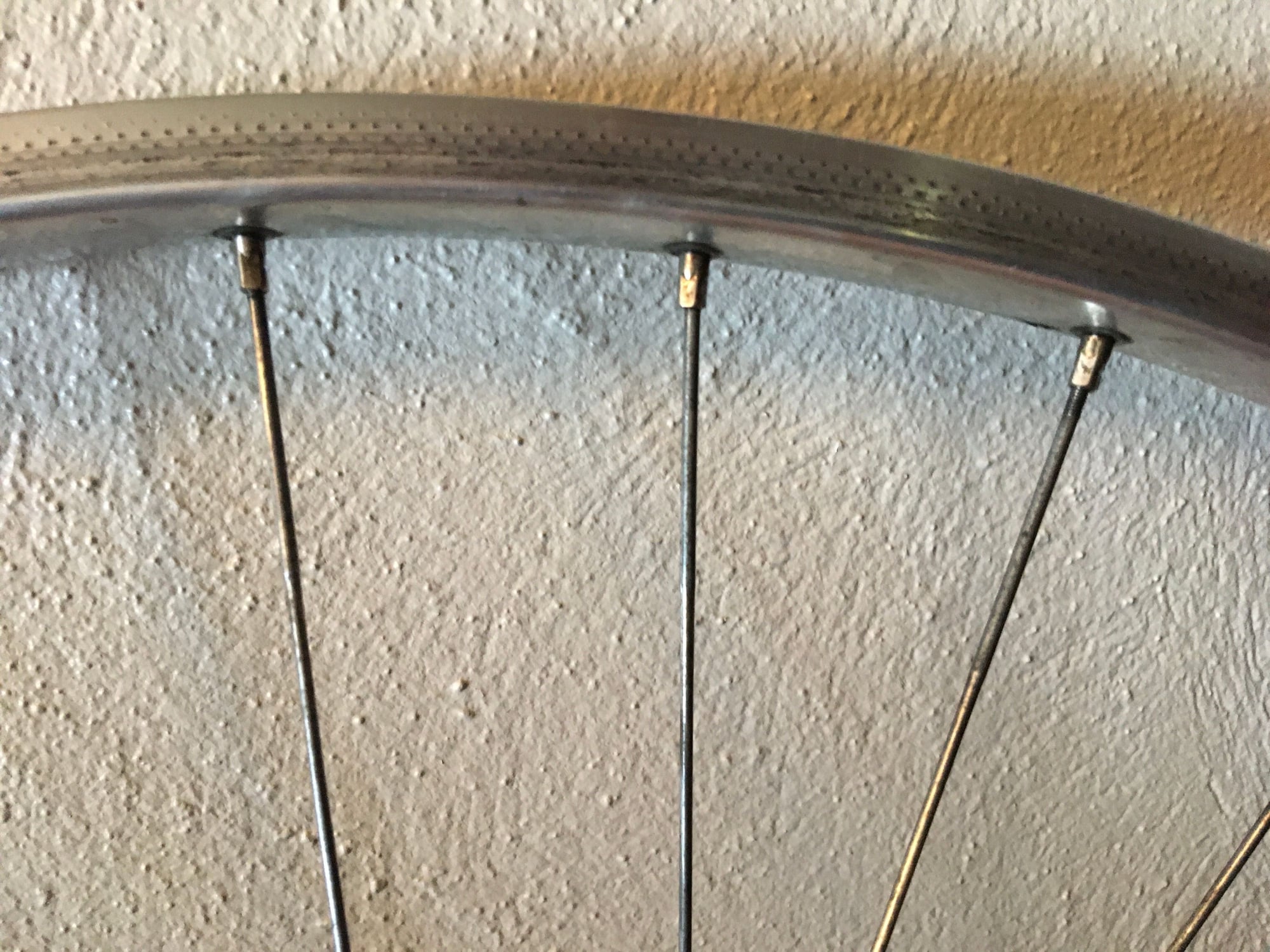
On this second photo, a drive side spoke is in the center. To the left is nds that is fine. To the right is nds that is showing lots of threads and is perhaps 3-4mm short in the spoke nipple head. Putting my spoke ruler to just the nds spokes and measuring from the hub spoke hole to the rim shows this regular pattern of being off by perhaps 3mm. This is a repeating pattern for all the nds spokes. That is why I thought that who ever laced it did something simple wrong 30-40 years ago.

Campy record 4X

On this second photo, a drive side spoke is in the center. To the left is nds that is fine. To the right is nds that is showing lots of threads and is perhaps 3-4mm short in the spoke nipple head. Putting my spoke ruler to just the nds spokes and measuring from the hub spoke hole to the rim shows this regular pattern of being off by perhaps 3mm. This is a repeating pattern for all the nds spokes. That is why I thought that who ever laced it did something simple wrong 30-40 years ago.
Likes For sd5782:
#8
Senior Member
Thread Starter
Join Date: Jan 2019
Location: Toledo Ohio
Posts: 1,497
Bikes: 1964 Huffy Sportsman, 1972 Fuji Newest, 1973 Schwinn Super Sport (3), 1982 Trek 412, 1983 Trek 700, 1989 Miyata 1000LT, 1991 Bianchi Boardwalk, plus others
Mentioned: 21 Post(s)
Tagged: 0 Thread(s)
Quoted: 583 Post(s)
Liked 700 Times
in
395 Posts
I guess my point is that many years ago it seems some builders stuck with just one size spoke for front and rear and nds and ds. Perhaps it was a speed of building thing, but it is what I have seen on these sets. On the Phil set, the spokes should have been 1-2mm longer. I just assumed that was just the way they did things way back.
#9
Senior Member
Join Date: Oct 2014
Location: Portland, OR
Posts: 12,910
Bikes: (2) ti TiCycles, 2007 w/ triple and 2011 fixed, 1979 Peter Mooney, ~1983 Trek 420 now fixed and ~1973 Raleigh Carlton Competition gravel grinder
Mentioned: 129 Post(s)
Tagged: 0 Thread(s)
Quoted: 4806 Post(s)
Liked 3,933 Times
in
2,558 Posts
A five speed wheel has little enough dish that you could usually get away with the same spokes throughout the wheel. But the NDS sure looks like a case of starting om the wrong hole and making it work. Looks like it did too. I wouldn't mess with anything I don't absolutely have to on that wheel and just ride it until issues show up, then rebuild. (Yes, when you do you will be making new grooves in the hub flange. A no-no but it is not your fault that you have to. And I bet if you don't tel anybody, you will get away with it.)
I love seeing 4X wheels. I've rolled thousands of miles on them. Had some that went ridiculous distances. Laced like yours on light galvanized butted spokes. Spokes overlapping and bending around the neighboring heads. And on those huge flanged Tipo hubs. Real interference. My preferred - still - commuter front. Those hubs roll forever. (And getting told many times that's a head popper.) Sadly, almost all my bikes are now 32 hole and 4X really doesn't work.
I love seeing 4X wheels. I've rolled thousands of miles on them. Had some that went ridiculous distances. Laced like yours on light galvanized butted spokes. Spokes overlapping and bending around the neighboring heads. And on those huge flanged Tipo hubs. Real interference. My preferred - still - commuter front. Those hubs roll forever. (And getting told many times that's a head popper.) Sadly, almost all my bikes are now 32 hole and 4X really doesn't work.
Likes For 79pmooney:
#10
Really Old Senior Member
I guess my point is that many years ago it seems some builders stuck with just one size spoke for front and rear and nds and ds. Perhaps it was a speed of building thing, but it is what I have seen on these sets. On the Phil set, the spokes should have been 1-2mm longer. I just assumed that was just the way they did things way back.
If not, you don't know what may have been done to it.
How much thread is in the nipple is what matters.
Maybe somebody put the chain on the wrong side of the largest cog and nicked the "elbows out" spokes which were replaced with a different length spoke because that's what they had.
You can digress about what they did in the old days, but it doesn't accomplish a thing today.
Likes For Bill Kapaun:
#11
Senior Member
Thread Starter
Join Date: Jan 2019
Location: Toledo Ohio
Posts: 1,497
Bikes: 1964 Huffy Sportsman, 1972 Fuji Newest, 1973 Schwinn Super Sport (3), 1982 Trek 412, 1983 Trek 700, 1989 Miyata 1000LT, 1991 Bianchi Boardwalk, plus others
Mentioned: 21 Post(s)
Tagged: 0 Thread(s)
Quoted: 583 Post(s)
Liked 700 Times
in
395 Posts
Interesting point on elbow out spokes being changed, and obviously, I don’t know the history of the wheel. I will measure when I detension to change nipples and possibly figure things out. Perhaps I wasn’t explaining it clearly, but measuring from hub to rim on the confusing side gave two distinct measurements when measuring along the paths of the spokes from hub to rim. No matter the length of the spokes, I would think this measurement would be the same if it was laced correctly.
#12
Senior Member
Thread Starter
Join Date: Jan 2019
Location: Toledo Ohio
Posts: 1,497
Bikes: 1964 Huffy Sportsman, 1972 Fuji Newest, 1973 Schwinn Super Sport (3), 1982 Trek 412, 1983 Trek 700, 1989 Miyata 1000LT, 1991 Bianchi Boardwalk, plus others
Mentioned: 21 Post(s)
Tagged: 0 Thread(s)
Quoted: 583 Post(s)
Liked 700 Times
in
395 Posts
I think I may have figured it out, and it may be that the non drive side was assembled one hole off in the counterclockwise position. Looking at my Jobst Brandt book it doesn’t seem to match the first pic I posted. I put my spoke ruler to the hub positioned 1 hole over and measured to the rim in the appropriate landing spot. I did this for trailing and leading spokes and got the same measurement unlike how it is now.
I could just leave it alone as 79pmooney says, but where’s the fun in that. I rode my old Super Sport with front spokes perhaps 5mm short for 40 years with no problems. That one had a new rim installed by a lbs after a crash and I was blissfully ignorant of it for decades with no trouble. Winter is time in the Midwest for indoor projects, but it was upper 50s yesterday with a light wind, so I did get in 15 miles on another bike.
I could just leave it alone as 79pmooney says, but where’s the fun in that. I rode my old Super Sport with front spokes perhaps 5mm short for 40 years with no problems. That one had a new rim installed by a lbs after a crash and I was blissfully ignorant of it for decades with no trouble. Winter is time in the Midwest for indoor projects, but it was upper 50s yesterday with a light wind, so I did get in 15 miles on another bike.
Likes For sd5782:
#13
Senior Member
Join Date: Apr 2009
Location: New Rochelle, NY
Posts: 38,729
Bikes: too many bikes from 1967 10s (5x2)Frejus to a Sumitomo Ti/Chorus aluminum 10s (10x2), plus one non-susp mtn bike I use as my commuter
Mentioned: 140 Post(s)
Tagged: 1 Thread(s)
Quoted: 5793 Post(s)
Liked 2,595 Times
in
1,438 Posts
It's impossible to tell from the photo, but, your initial description hints that the flanges may not be "phased" correctly.
Take a rod of some kind, ie. a knitting needle and locate any pair of spokes going in the same direction, from opposite flanges. Using the rod as a reference, or eyeball, and identify which is a half hole position forward of the other. Follow both to the rim, and they should get there in the same order.
There are other possibilities, but one thing at a time.
Take a rod of some kind, ie. a knitting needle and locate any pair of spokes going in the same direction, from opposite flanges. Using the rod as a reference, or eyeball, and identify which is a half hole position forward of the other. Follow both to the rim, and they should get there in the same order.
There are other possibilities, but one thing at a time.
__________________
FB
Chain-L site
An ounce of diagnosis is worth a pound of cure.
Just because I'm tired of arguing, doesn't mean you're right.
ďOne accurate measurement is worth a thousand expert opinionsĒ - Adm Grace Murray Hopper - USN
WARNING, I'm from New York. Thin skinned people should maintain safe distance.
FB
Chain-L site
An ounce of diagnosis is worth a pound of cure.
Just because I'm tired of arguing, doesn't mean you're right.
ďOne accurate measurement is worth a thousand expert opinionsĒ - Adm Grace Murray Hopper - USN
WARNING, I'm from New York. Thin skinned people should maintain safe distance.
#14
Senior Member
Join Date: Apr 2009
Location: New Rochelle, NY
Posts: 38,729
Bikes: too many bikes from 1967 10s (5x2)Frejus to a Sumitomo Ti/Chorus aluminum 10s (10x2), plus one non-susp mtn bike I use as my commuter
Mentioned: 140 Post(s)
Tagged: 1 Thread(s)
Quoted: 5793 Post(s)
Liked 2,595 Times
in
1,438 Posts
I loved building them for years. Through the mid seventies, I built just about all wheels 4x, except for racing, and if specifically asked not to.
But it had nothing to do with any technical advantage. I avoided revealing my secret reason, but I've declassified it since.
4x 36h wheels are full tangent, so flange diameter doesn't matter. Since rims of that era had similar depths, I could buy my favored 305mm DB Stella spokes in massive lots, saving real dough.
No calculator needed, any length you want as long as it's 305.
But it had nothing to do with any technical advantage. I avoided revealing my secret reason, but I've declassified it since.
4x 36h wheels are full tangent, so flange diameter doesn't matter. Since rims of that era had similar depths, I could buy my favored 305mm DB Stella spokes in massive lots, saving real dough.
No calculator needed, any length you want as long as it's 305.
Likes For FBinNY:
#15
Senior Member
Join Date: Apr 2009
Location: New Rochelle, NY
Posts: 38,729
Bikes: too many bikes from 1967 10s (5x2)Frejus to a Sumitomo Ti/Chorus aluminum 10s (10x2), plus one non-susp mtn bike I use as my commuter
Mentioned: 140 Post(s)
Tagged: 1 Thread(s)
Quoted: 5793 Post(s)
Liked 2,595 Times
in
1,438 Posts
I built countless wheels in that era, almost all 4x 36h plus a few 32hF/40hR.
I never thought about it at the time, except for the convenience factor of using the same spoke regardless of the hub. In later years, I started wondering if spoke length considerations were a factor in 36h becoming standard.
Keep in mind, there was no internet. Nobody had a computer, and the HP scientific calculator didn't exist yet. Building 4x36h simplified things because you could do a spoke calculation in your head by simply making an adjustment for the rim.
Later, I started building more different pattern wheels, and had to design my own analog computer to calculate lengths. But the appreciation for the sheer beauty of 4x36h never left me.
BTW if your wondering about the galvanized spokes, it was probably that SS spoke were still relatively new, and not trusted as much as carbon steel spokes which were stronger.
#16
Senior Member
I loved building them for years. Through the mid seventies, I built just about all wheels 4x, except for racing, and if specifically asked not to.
But it had nothing to do with any technical advantage. I avoided revealing my secret reason, but I've declassified it since.
4x 36h wheels are full tangent, so flange diameter doesn't matter. Since rims of that era had similar depths, I could buy my favored 305mm DB Stella spokes in massive lots, saving real dough.
No calculator needed, any length you want as long as it's 305.
But it had nothing to do with any technical advantage. I avoided revealing my secret reason, but I've declassified it since.
4x 36h wheels are full tangent, so flange diameter doesn't matter. Since rims of that era had similar depths, I could buy my favored 305mm DB Stella spokes in massive lots, saving real dough.
No calculator needed, any length you want as long as it's 305.
#17
Senior Member
Thread Starter
Join Date: Jan 2019
Location: Toledo Ohio
Posts: 1,497
Bikes: 1964 Huffy Sportsman, 1972 Fuji Newest, 1973 Schwinn Super Sport (3), 1982 Trek 412, 1983 Trek 700, 1989 Miyata 1000LT, 1991 Bianchi Boardwalk, plus others
Mentioned: 21 Post(s)
Tagged: 0 Thread(s)
Quoted: 583 Post(s)
Liked 700 Times
in
395 Posts
And yes, this set looks to be 305mm as was the set on the Phils from the 70s.
#18
Senior Member
Join Date: Apr 2009
Location: New Rochelle, NY
Posts: 38,729
Bikes: too many bikes from 1967 10s (5x2)Frejus to a Sumitomo Ti/Chorus aluminum 10s (10x2), plus one non-susp mtn bike I use as my commuter
Mentioned: 140 Post(s)
Tagged: 1 Thread(s)
Quoted: 5793 Post(s)
Liked 2,595 Times
in
1,438 Posts
FWIW I'd date them to the late sixties. That hub first hit the market in 65 or 66, and while produced into the early 70s, the trend to SF was well underway by then.
The one thing I know for sure is I didn't build them ----- wrong brand spokes.
BTW check the flange phasing like I suggested earlier and post the results, so we can resolve the lacing mystery.
The one thing I know for sure is I didn't build them ----- wrong brand spokes.
BTW check the flange phasing like I suggested earlier and post the results, so we can resolve the lacing mystery.
#19
aged to perfection
Join Date: Jun 2009
Location: PacNW
Posts: 1,820
Bikes: Dinucci Allez 2.0, Richard Sachs, Alex Singer, Serotta, Masi GC, Raleigh Pro Mk.1, Hetchins, etc
Mentioned: 24 Post(s)
Tagged: 0 Thread(s)
Quoted: 840 Post(s)
Liked 1,263 Times
in
667 Posts
4X wheels are "full tangent" ???
Can you explain what that means please ? do you mean the spoke is tangent to the hub flange ?
I don't care for 4x hi flange lacing because the spoke enters the rim at an angle that is not perpendicular to the tangent at that point.
it's a small point.
/markp
Can you explain what that means please ? do you mean the spoke is tangent to the hub flange ?
I don't care for 4x hi flange lacing because the spoke enters the rim at an angle that is not perpendicular to the tangent at that point.
it's a small point.
/markp
#20
Senior Member
Join Date: Apr 2009
Location: New Rochelle, NY
Posts: 38,729
Bikes: too many bikes from 1967 10s (5x2)Frejus to a Sumitomo Ti/Chorus aluminum 10s (10x2), plus one non-susp mtn bike I use as my commuter
Mentioned: 140 Post(s)
Tagged: 1 Thread(s)
Quoted: 5793 Post(s)
Liked 2,595 Times
in
1,438 Posts
4X wheels are "full tangent" ???
Can you explain what that means please ? do you mean the spoke is tangent to the hub flange ?
I don't care for 4x hi flange lacing because the spoke enters the rim at an angle that is not perpendicular to the tangent at that point.
it's a small point.
/markp
Can you explain what that means please ? do you mean the spoke is tangent to the hub flange ?
I don't care for 4x hi flange lacing because the spoke enters the rim at an angle that is not perpendicular to the tangent at that point.
it's a small point.
/markp
As for how it meets the rim, yes there's a difference, but it's really never been an issue. The angle at the rim doesn't become a problem until flanges get much larger, like with drum brakes, where you must reduce crosses to manage it. It's why motor hub wheels are usually only 1 or 2 cross.
__________________
FB
Chain-L site
An ounce of diagnosis is worth a pound of cure.
Just because I'm tired of arguing, doesn't mean you're right.
ďOne accurate measurement is worth a thousand expert opinionsĒ - Adm Grace Murray Hopper - USN
WARNING, I'm from New York. Thin skinned people should maintain safe distance.
FB
Chain-L site
An ounce of diagnosis is worth a pound of cure.
Just because I'm tired of arguing, doesn't mean you're right.
ďOne accurate measurement is worth a thousand expert opinionsĒ - Adm Grace Murray Hopper - USN
WARNING, I'm from New York. Thin skinned people should maintain safe distance.
Likes For FBinNY:
#21
Senior Member
Thread Starter
Join Date: Jan 2019
Location: Toledo Ohio
Posts: 1,497
Bikes: 1964 Huffy Sportsman, 1972 Fuji Newest, 1973 Schwinn Super Sport (3), 1982 Trek 412, 1983 Trek 700, 1989 Miyata 1000LT, 1991 Bianchi Boardwalk, plus others
Mentioned: 21 Post(s)
Tagged: 0 Thread(s)
Quoted: 583 Post(s)
Liked 700 Times
in
395 Posts
Update
I did some studying and measuring on another 4X set I had, and also compared this to the front rim on the same bike. Interestingly, I had wheels that were clocked either way when looking at the rim. It seems that the original builder should have started one hole over on the hub. I was still confused looking at it, but tore down the offending NDS except for just one spoke. I then saw where the spoke should land on the rim and measured to be sure it was what I wanted. This would keep the spokes heads on the original side of the rim. It seems that being clocked the “wrong” way would have worked too if the spokes landed in a different spot on the rim.
Effectively this is what I did, flipping the leading and trailing spokes and also turned it into a mirror image or symmetrical pattern if that is what it is called. All that wound up placing the valve hole not between parallel spokes. This was remedied by moving the whole 36 spokes one hole over. The Champion 58s allowed this as the spoke holes are centered on the rim. I didn’t snug anything up yet as I want to put a dab of grease on things first before tensioning.
As an aside, all the spokes were 307mm. Spoke calc says 307.6 or 307.7 for everything except the DS rear which is 306.7. That valve stem hole clocked wrong brings up another question for another day when applied to rims with offset spoke holes like one set I have. No pics yet as the wheel is ugly of course with nothing snugged up. Hope this isn’t too confusing sounding.
I did some studying and measuring on another 4X set I had, and also compared this to the front rim on the same bike. Interestingly, I had wheels that were clocked either way when looking at the rim. It seems that the original builder should have started one hole over on the hub. I was still confused looking at it, but tore down the offending NDS except for just one spoke. I then saw where the spoke should land on the rim and measured to be sure it was what I wanted. This would keep the spokes heads on the original side of the rim. It seems that being clocked the “wrong” way would have worked too if the spokes landed in a different spot on the rim.
Effectively this is what I did, flipping the leading and trailing spokes and also turned it into a mirror image or symmetrical pattern if that is what it is called. All that wound up placing the valve hole not between parallel spokes. This was remedied by moving the whole 36 spokes one hole over. The Champion 58s allowed this as the spoke holes are centered on the rim. I didn’t snug anything up yet as I want to put a dab of grease on things first before tensioning.
As an aside, all the spokes were 307mm. Spoke calc says 307.6 or 307.7 for everything except the DS rear which is 306.7. That valve stem hole clocked wrong brings up another question for another day when applied to rims with offset spoke holes like one set I have. No pics yet as the wheel is ugly of course with nothing snugged up. Hope this isn’t too confusing sounding.
#22
Senior Member
Join Date: Apr 2016
Posts: 1,245
Mentioned: 3 Post(s)
Tagged: 0 Thread(s)
Quoted: 505 Post(s)
Liked 437 Times
in
336 Posts
Christmas 1977 I was given a TI-58 programmable calculator, I think I still have it, it was working the last time I saw it maybe 20 years ago. I'm almost inspired to dig it out and write a spoke calculator. Almost - it doesn't have tertiary storage (the next model up had magnetic cards) so you have to key in the code every time, and I don't think you can edit it once loaded. Actually I just found an emulator (a Windows executable, but never mind) so maybe ...
#23
Really Old Senior Member
......
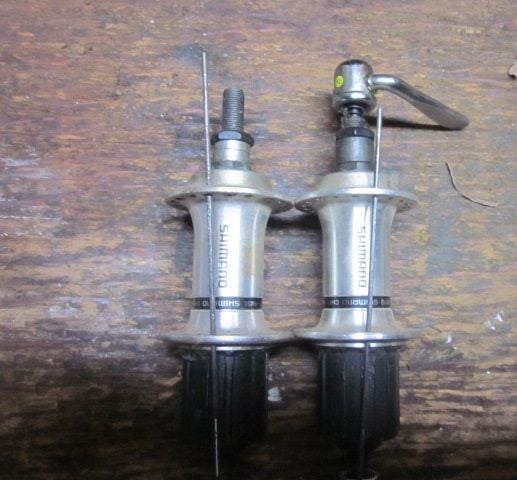
Take a rod of some kind, ie. a knitting needle and locate any pair of spokes going in the same direction, from opposite flanges. Using the rod as a reference, or eyeball, and identify which is a half hole position forward of the other. Follow both to the rim, and they should get there in the same order.......

Take a rod of some kind, ie. a knitting needle and locate any pair of spokes going in the same direction, from opposite flanges. Using the rod as a reference, or eyeball, and identify which is a half hole position forward of the other. Follow both to the rim, and they should get there in the same order.......
It took a couple wheels before the light bulb went off.
To address (I think) one of your other questions when dealing with a "left hand" vs "right hand" rim re: the nipple holes.
If you consider RH the :norm", when dealing with a LH rim, start the key spoke in the 2nd hole from the valve.
Scroll down to Key Spoke-
https://www.sheldonbrown.com/wheelbuild.html
Likes For Bill Kapaun:
#24
Senior Member
Thread Starter
Join Date: Jan 2019
Location: Toledo Ohio
Posts: 1,497
Bikes: 1964 Huffy Sportsman, 1972 Fuji Newest, 1973 Schwinn Super Sport (3), 1982 Trek 412, 1983 Trek 700, 1989 Miyata 1000LT, 1991 Bianchi Boardwalk, plus others
Mentioned: 21 Post(s)
Tagged: 0 Thread(s)
Quoted: 583 Post(s)
Liked 700 Times
in
395 Posts
Success I think
About 90% up to tension and spoke location inside the nipples is very nice, and consistent. DS mostly at screw slot +/- a mm or so. NDS down perhaps a mm or two. I donít really know what I am doing, but having a spare wheel for a pattern helps too. The way I corrected things keeping the spoke head on the same side as it was kept the hub looking nice on the outside at the spoke holes not showing any damage. The takeaway though was that there are a couple of ways to do this even if one desires to clock the hub differently than conventional. (And the original builder did several things wrong).
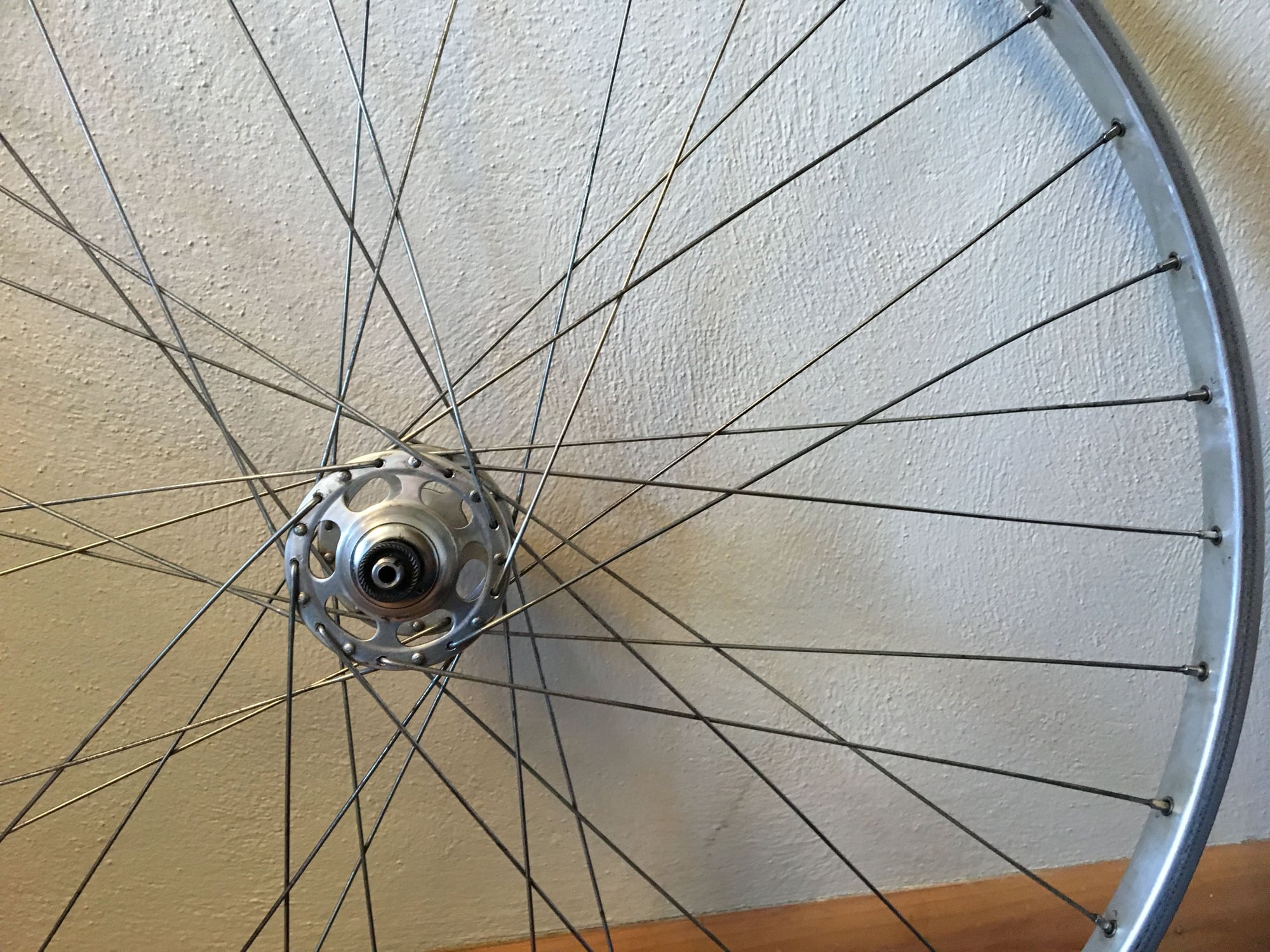
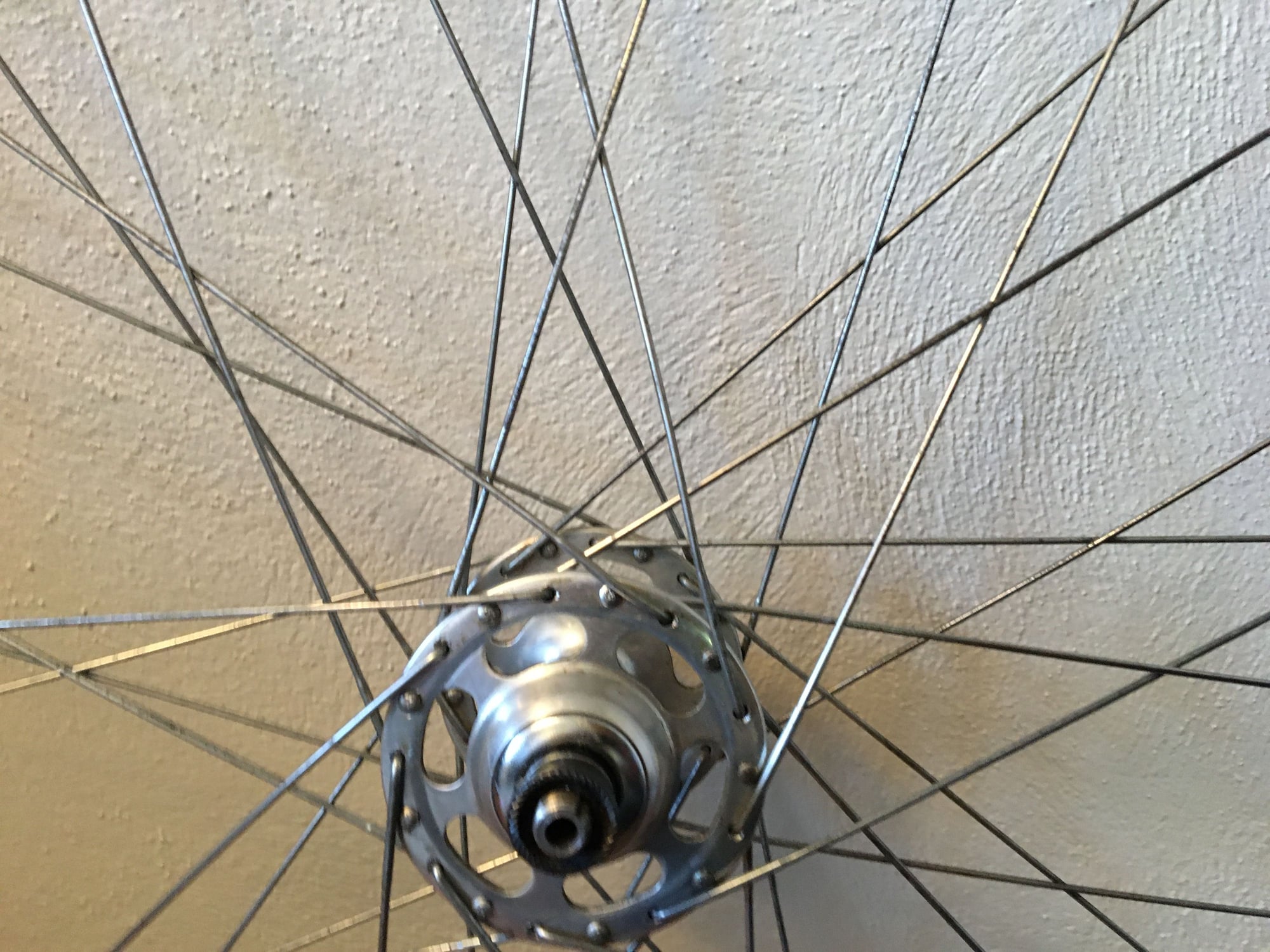
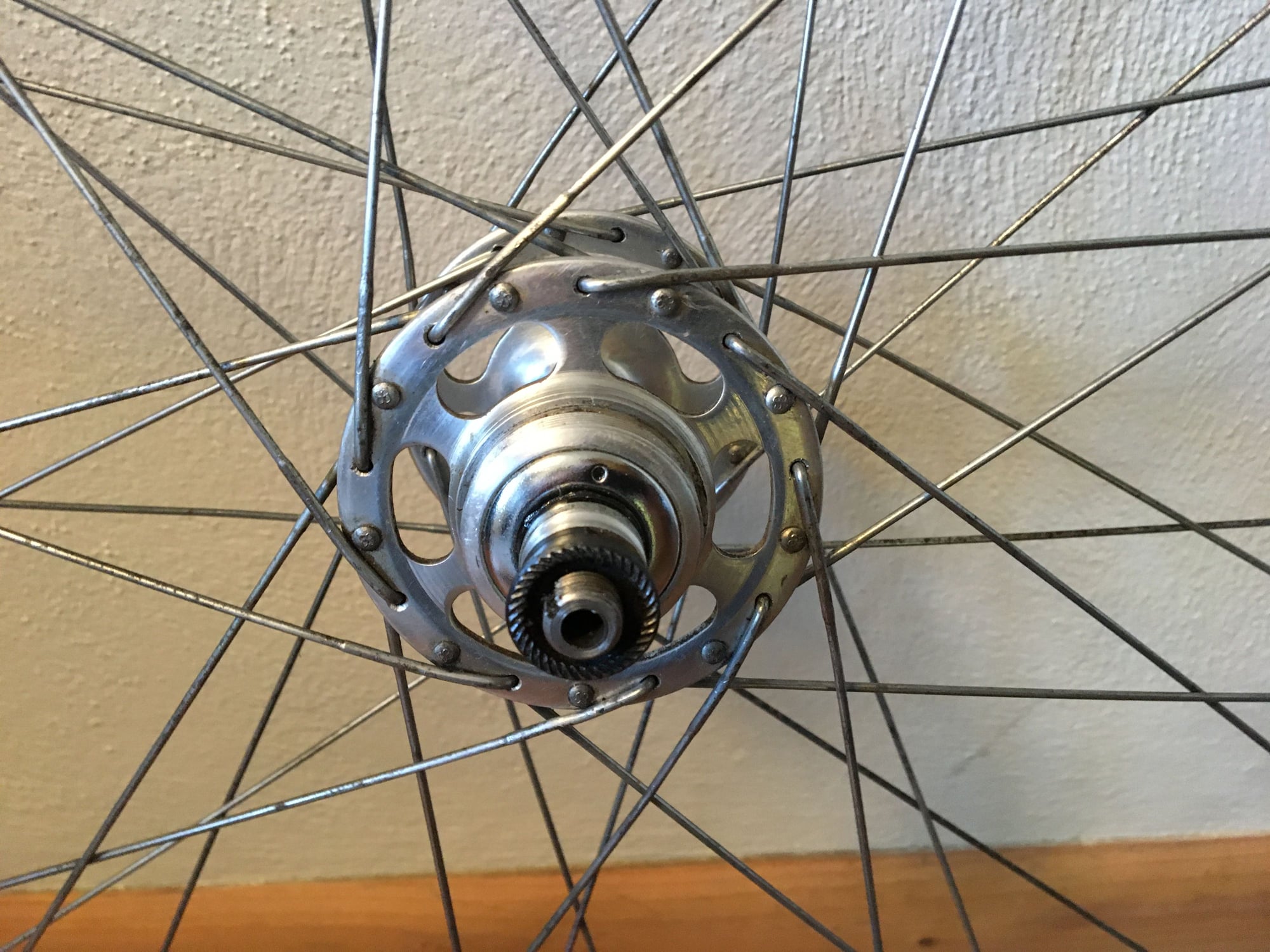
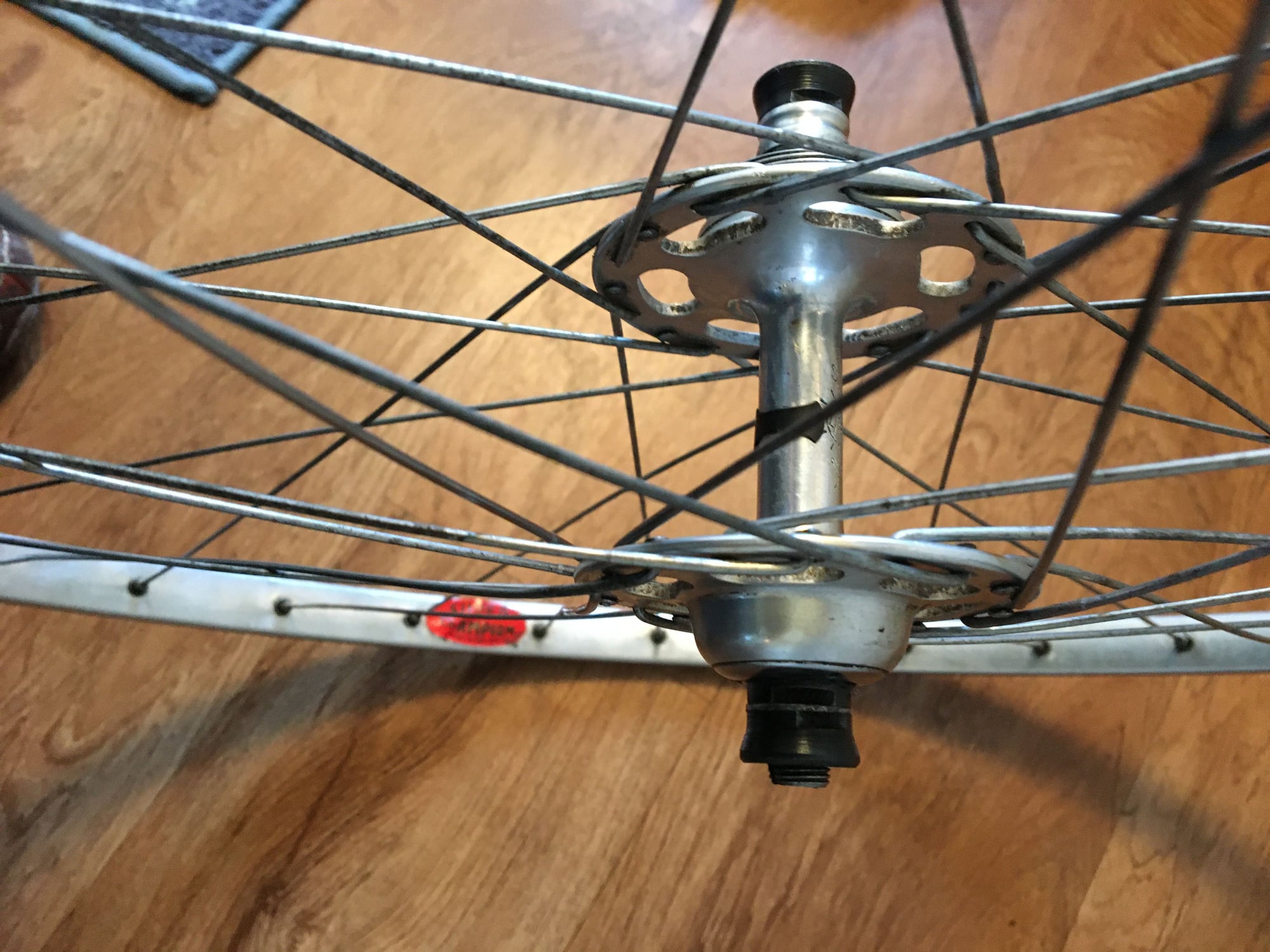




#25
Senior Member
Join Date: Apr 2016
Posts: 1,245
Mentioned: 3 Post(s)
Tagged: 0 Thread(s)
Quoted: 505 Post(s)
Liked 437 Times
in
336 Posts
About 90% up to tension and spoke location inside the nipples is very nice, and consistent. DS mostly at screw slot +/- a mm or so. NDS down perhaps a mm or two. I donít really know what I am doing, but having a spare wheel for a pattern helps too. The way I corrected things keeping the spoke head on the same side as it was kept the hub looking nice on the outside at the spoke holes not showing any damage. The takeaway though was that there are a couple of ways to do this even if one desires to clock the hub differently than conventional. (And the original builder did several things wrong).




